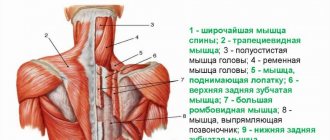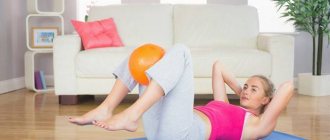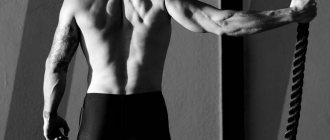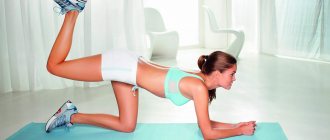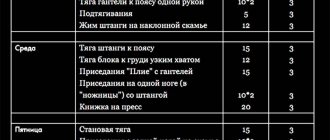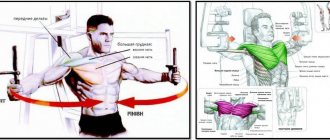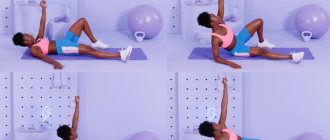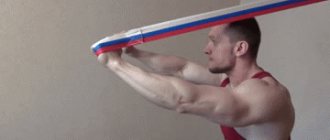For those who are engaged in self-improvement of their physical fitness, it seems that the most important thing is to increase the volume of the biceps, triceps, pectoral muscles and to define the “cubes” on the press. However, it is important for the harmonious development of the body to pump up the neck.
An expressively sculpted neck area is considered and is an indicator of the strength of the male body. After all, the neck, unlike the pectoral or back muscles, cannot be hidden under clothing, except perhaps under a scarf in winter. It is precisely the pumping up of this part of the body that characterizes the qualifications of the athlete.
You can achieve perfection in this regard at home. You just need to put in the effort and work hard. Regular and correct implementation of specialized training will result in noticeable visual changes within a month - the cervical area will become strong, wide and beautiful.
The main thing in this matter is not to rush and not to force events. Otherwise, instead of satisfaction from the work done, you will get health problems.
Anatomy and function of the neck muscles
Among the cervical muscles, the following groups are distinguished:
- superficial,
- median,
- deep,
- lateral.
The superficial group consists of the sternocleidomastoid muscle and the thin subcutaneous muscle. The first becomes noticeable when turning the head to the side - a cord appears on the neck. Performs the functions of supporting the head and making it bend and bend. The subcutaneous is located under the skin. It tightens the skin of the neck and sternum.
The middle group is located behind the superficial muscles. Some of them are located above the hyoid bone, others below it. They manipulate the tongue and jaw.
The deep group consists of the anterior rectus capitis, lateral rectus, long rectus, and trapezius muscles. All of them are responsible for tilting the head in the desired direction and tilting the spine forward.
The lateral muscle group includes the trapezius, anterior and posterior scalene. They are involved in tilting the neck in different directions and raising the first and second ribs.
In addition to the muscles, nerve fibers pass through this area, as well as blood vessels that work to supply blood to the brain and other structures of the body.
Training on the horizontal bar
How to pump up your neck muscles? A good solution is to organize training using a horizontal bar. First you need to learn how to freely pull yourself up several dozen times. When the muscle corset of the upper body is well strengthened, you can proceed directly to using the neck muscles. We are talking about changing the grip during pull-ups. First, arms are placed as wide as possible. During the next approach, the grip is changed to medium and then to narrow. Thus, a variety of neck muscles are tense.
Gradually the number of repetitions should be increased. Subsequently, you can move on to pull-ups with a bar placed behind the back of your head. A variety of body movements increases the load on the neck muscles and provokes an active increase in muscle mass in the target area.
How to pump up your neck muscles
Pumping up your neck at home is necessary, as they say, with feeling, tact, and arrangement. You should not rush anywhere, so as not to provoke cramps in the neck muscles. Excessive load threatens overwork of the muscle material and its ruptures.
Do not forget that this area contains the vital centers of the body.
Start training with a partner - it’s easier and safer. And, if you want, more fun. Initially, decide which muscle group you need to pump up first.
Entry level exercises
The following is an example of how to pump up your neck at home.
This neck muscle workout is performed without dumbbells, weights or other weights. Your own hands and a towel are enough.
Neck flexion and extension
Sit on a chair located in front of the table. Place your elbows on the table, tilt your head and place your forehead on the table surface.
- Grasp your head with your hands and press on it from above. Use your neck muscles to try to lift your head. Measure the force in your arms so that you can still raise your head, but with effort. It is important to give stress and not damage your neck.
- Do 10-12 of these movements under pressure from your hands.
You can use a towel instead of hands - it will even be more convenient. Next, we train the opposite muscles.
- Now, at the same table, rest your forehead on your palms. Elbows are on the table.
- Try to press your elbows into the table.
This is a static exercise; if you want dynamics, you will need a rubber band.
- Hold its ends firmly in two hands, on the sides of your head, and pull the middle across your forehead. Move your hands back a little, but so that you feel comfortable.
- Tilt your head down - the band will provide resistance and the muscles will be trained.
- Repeat 10–12 times.
This is a safe way to train your neck muscles.
Flexion and extension can be performed using your own head weight. It doesn't weigh as little as you think.
- Lie on your back or stomach. The head should hang.
- Raise your head under your own weight 3-4 sets of 15 times.
This is an excellent exercise for those people whose neck muscles are not yet strong enough. This is also a good example of how to pump up your neck at home without much difficulty.
Lateral muscle training
This exercise is done from a sitting position and illustrates well how to strengthen the muscles of the neck from the side.
- Place your hands on the sides of your head.
- Tilt your head 10 times in each direction (right and left), offering resistance with the same hand.
You can hold the movement, then you will do static training. Or give in, then the head will move to the side and the result will be dynamics.
Naturally, training with weights is much more interesting and relevant than this way. But if you have diseases of the cervical spine, training with weights is prohibited.
In order for the neck muscles to gradually strengthen at home, you need to give them a progressive load. You can increase the number of repetitions or sets, or perform other exercises.
If your cervical spine is completely healthy and you intend to pump your muscles further, after several months of such gymnastics you can move on to a heavier load.
Now let's look at how to pump up your neck muscles with weights.
Exercises to warm up and stretch the neck muscles
Before starting classes, warm up for about five to six minutes. This will ensure that you warm up your muscles and protect them from injuries and microdamages.
Athletes recommend supplementing the neck warm-up with stretching. Schedule it for the end of the first set of exercises. Stretching usually takes no more than three to five minutes.
So, the warm-up “menu” includes exercises such as:
- tilting the head forward, backward and to the sides;
- head rotation;
- turns with fixed shoulders.
The exercises are performed comprehensively, 15-20 repetitions. Starting position: straight stand, feet shoulder-width apart, arms down along the body.
Stretching should be done immediately after warming up, however, it is not forbidden to carry it over to the final stage of training. Do as you please.
To warm up the back of the neck, tilt your head with your chin resting on your chest.
To work the lateral muscles, raise one arm, bend it and reach the opposite ear with your fingers. Then do the same with raising the other arm.
To work on the front surface of the neck, fingers are interlocked at the back of the head. Supporting your head, tilt it back.
Remember: you can’t do exercises through pain and when you can’t, never hold your breath and don’t rush.
Indirect neck exercises
These are exercises in which the neck muscles receive indirect load. And the purpose of these exercises is to develop other muscles, however, the neck muscles also develop well. As a rule, exercises for the trapezius muscles have a good effect on the development of neck muscles. And this is not surprising! After all, the cervical and trapezius muscles work in one ligament.
Shrugs with dumbbells or barbell
The exercise is performed with dumbbells or a barbell held in lowered hands. Raise and lower your shoulders without bending your elbows. At the same time, move your shoulders back a little. This will increase the impact on the trapezius muscles. Many athletes recommend that when using significant weight (25 kg or more in each hand) keep your head slightly tilted forward to avoid pinching and increase the amplitude of shrugs.
Shrugs with a barbell
Shrugs with a barbell
Side plank
And this exercise is not at all intended for the neck muscles. However, they actively work and develop, since in the plank position we are forced to keep our heads hanging. The lateral neck muscles get a very good workout if you stand in the side plank for 30-60 seconds or more.
The side plank exercise is great for training your neck muscles.
Lying straight leg raises
Leg raises are designed to train the abdominal and thigh muscles. However, if you keep your head up, this is an excellent workout for the anterior neck muscles. By the way, I prescribe this exercise to people with cervical hyperlordosis and slouching to balance their overly tight posterior neck muscles and thoracic spine.
Leg lifts are done smoothly. When raising your legs, exhale, when lowering, inhale. Usually perform 3 sets of 15-30 repetitions.
Lying straight leg raises. Start.
Lying straight leg raises. Finish.
Overcoming opposition
This initial stage in pumping up the neck is preparing the muscles for more powerful loads:
- The opening exercise consists of the following arrangement: we place our palms on our foreheads and vigorously press them on it. The head should remain motionless due to the counter-force of the neck;
- the second exercise is of a similar type, only this time you need to press your palms alternately on the left and right temporal lobe. Repeat 30 times for each side;
- and the last exercise is suitable provided that the training is carried out with a partner. You lie on your stomach on the bench, and your partner begins to press on the back of your head. Your task is to resist the pressure.
It is also possible to perform the exercise while lying on your side.
How to stretch your neck at home
All strength exercises for pumping up mass must be done after warming up. At the same time, it is useful to perform the warm-up itself every day and as a separate complex at home, which can be performed without any exercise equipment.
Trapezius stretch
The trapezius muscle runs from the back to the neck. She is responsible for tilting and turning her head; it is very important to prepare her for training:
- Place your right hand on the back of your head, slightly to the left.
- Tilt your head forward in the direction of movement of your hand, that is, diagonally to the right and down.
- Stay in this position for 20 seconds.
- Repeat on the other side.
- Do 2-3 approaches.
The video shows how to properly pump your neck to increase muscle size.
Video: Trapezius stretch
Tilts the head back and forth
The amplitude should be small: do not throw your head back too much, so as not to injure the vertebrae and not to compress the nerves and blood vessels.
- As you exhale, tilt your head forward without changing the position of your back. Gently pull your chin towards your chest.
- As you inhale, tilt your head back, pull your chin as high as possible, keep your shoulders down. Stay in the bend for 2 seconds and return to the starting position.
- Do 6-10 reps.
Tilts of head to shoulders
Try not to reach your lower ear toward your shoulder, but your upper ear toward the ceiling.
- As you exhale, tilt your head to the side so that your ear moves towards your shoulder.
- As you inhale, return to the center.
- Exhale and repeat on the other side.
- You can help yourself with your hand.
- Do 6-10 repetitions, holding each side for a couple of seconds.
In the last bend on each side, you can linger a little longer by placing the palm of the opposite hand on your upper ear. The pressure can only be very soft and pleasant; there should be no discomfort and, especially, pain under any circumstances.
Circular movements of the head
Slowly and smoothly make 4-8 circular movements with your head, first in one direction, then in the other. When the movement goes up, inhale; when down, exhale. Do not forget that the amplitude should be small and comfortable.
Head tilts back and forth, side bends, rotations
Strength exercises for pumping up the neck
This type of training system includes the following exercises:
- Place your head on the floor and spread your legs to double shoulder width. Then start turning your head back and forth and left and right for 20 repetitions. At first, you can support yourself with your hands, but in the future it is advisable to cross them behind your back and act exclusively with your head, moving the weight to the neck;
- Having become familiar with the first exercise, we move on to its more complicated form. To do this, stand on the bridge with your stomach up. We perform head movements from this position;
- among other things, the training system should consist of exercises without external resistance. One of them is called the “bar”. To perform it, they lower themselves to the floor, rest their elbows or palms, as well as their bent toes, on the floor surface. At the same time, the neck, torso and legs are retracted so that the body creates a straight line; the muscles need to be tense. It is necessary to hold the stance for as long as possible until you get slightly tired. There are front, side and back slats.
Why train your neck?
Our neck not only connects our head to the rest of our body, but also performs vital functions:
- The most important supply routes for the body pass through the neck: blood vessels, larynx, esophagus, trachea;
- the spine and neck muscles support the position of the head;
- neck muscles are involved in such important processes as swallowing and pronouncing sounds.
The neck muscles are divided into two large groups:
- Intrinsic or deep muscles: These help flex the head and body. These include the longus colli muscle and the longus capitis muscle.
- Participate in breathing by raising the ribs and bending the neck: the anterior, middle and posterior scalene muscles.
- The movement of the larynx is influenced by: the sublingual group (sterno-, scapular-, thyroid-, mental-) and the sternothyroid.
- Affect the movement of the larynx and lower jaw: digastric, mylohyoid, stylohyoid.
For what purposes do we train the neck?
Muscle pumping for health
If the neck muscles are not toned, our posture worsens and our back appears slouched. Often headaches are caused by poor blood supply to the brain - this is also affected by the muscles of the neck, which for one reason or another can be under constant strain, pinching nerves and blood vessels. By doing simple neck exercises several times a week, you can improve your well-being and performance.
For comfort
When we are stressed, our trapezius muscle contracts. This is a natural protective reaction of the body: this is how we gather our strength, roughly speaking, we prepare for battle. But it happens that the stress passes, but the tension in the neck remains. The paradox is that the weaker our muscles are, the worse stress affects them, the more they hold tension. At the same time, strong, developed muscles, on the contrary, easily relax. In addition, strengthening your neck muscles reduces stress from sitting at a desk for long hours.
Pump your neck for safety
Developed neck muscles can serve as a so-called airbag not only for athletes. And in ordinary life, anything can happen. The benefits of a strong neck have been proven more than once by accidents with athletes, whose neck muscles reduced the degree of concussion and prevented vertebral fractures. Obviously, this function of the neck is simply necessary for wrestlers and boxers.
Muscle training for athletic performance and strength
Strong neck muscles stabilize the thoracic spine. Thanks to this, athletes lift more weight in deadlifts, squats, and standing presses. And in football you can take the ball with your head. It's scary to imagine what could happen to the neck if an untrained person does this.
Shake your neck for beauty
If you are engaged in your physical fitness, you need to take care of every part of the body, including for the sake of aesthetics. Imagine a bodybuilder with a voluminous chest and impressive arms, but an insufficiently developed neck - the look is not very harmonious.
Exercises using additional weight
It is advisable to move on to exercises with weights after the previous complexes have been mastered. To properly perform a complex training system, you will need a head strap to which a weight is attached. When stretching a strap with a load, the distance to the floor should be 20-30 centimeters.
When performing the first exercise, bend towards the floor so that the load touches its surface, and then return to the starting position. It is advisable to increase the number of repetitions to 15-20 times.
The second exercise involves lying on a bench on your stomach or side. Here all the tension is transferred to the trapezius and lateral muscles.
Exercises
Neck flexion with disc
My favorite type of exercise that does not require any special equipment, all you need is a bench and a weight plate. There are two ways to perform this exercise. You can:
- Lie on the bench on your back, but in such a way that your head and neck hang freely over the edge.
- Lie down on the bench so that the upper half of your torso is completely on the bench, and your legs have firm support on the floor. Your body should be parallel to the floor surface and perpendicular to the bench.
In fact, it doesn’t really matter from what position you perform the exercise, decide for yourself, the effectiveness of the execution will be the same in any case. Place the weight plate on your forehead, holding it with your hands for balance, then continue to bend your neck, tilting your head forward, trying to touch your chin to your chest. Then remove the weight and return to the starting position, then repeat the exercise in the same sequence.
Some tips:
- Don't use too much weight.
- If possible, use the Olympic weight disc option, as it has a plastic coating on the outside and is more convenient to use.
- From a hygiene standpoint, it is recommended to use a towel, placing it between the weight disc and your face.
Neck Curl with Headgear
The principle of performing the exercise is similar to the previous one, but instead of a disc, special equipment is used - a head helmet. This type of equipment is not used in many gyms, so it is recommended to bring your own head helmet. Performing neck flexion exercises using it is not only more effective, but also a safer way, in my opinion.
Place a bench directly in front of a high pull block and sit with your back to it. Place a high pull block at head level, put on a headgear, and bend your head until your chin touches your chest. Then return to the starting position and repeat the exercise
There are different types of head helmets, but I personally prefer ones that fit completely around the head, like this one:
Neck bending in a special simulator
Although not a very common type of exercise machine, some gyms have dedicated equipment for working the muscles in the front of the neck. This simulator does everything for you, you just sit down, and a special “pillow” acts as a weighting agent. This will allow you to work your neck muscles by bending it forward in the same way as in the previously described exercises.
Don't worry, this is just a picture. Pay attention to the handles on the front of the machine, they are used for balance, so be sure to make sure you are holding them firmly while performing the exercise.
Neck extension exercise with disc
Now let's move on to the back muscles of the neck, namely the plaster muscle. As you probably guessed, training the back muscles of the neck according to the principle of execution is no different from everything that has already been said. There are many options for training this muscle; my favorite and most accessible is using a bench and a weighted disc.
You can sit on the bench in two ways:
- While sitting on a bench, lean forward until your stomach touches your thighs.
- Lying on your stomach, your head hangs slightly over the edge.
Personally, I prefer the first method, although both options are very good. Regardless of which method of placement on the bench you choose, the technique for performing the exercise will be the same. Place the disc behind your head and try to straighten your neck as much as possible. Lower your head down until your chin touches your upper chest and then repeat the exercise. It is recommended to place a towel between the disc and your head and control the holding of the disc behind your head with both hands.
Neck extension exercise with helmet
As mentioned earlier, you will need to purchase your own equipment to perform this exercise. Unlike exercises for the muscles of the front of the neck, there are two types of head helmets that can be used to work the muscles of the back of the neck: without weights and with weights. The first one is used on a high thrust projectile as follows:
- Sitting on a bench facing the direction of a high pull block
- Install the high-pull pin at the very bottom, attach the harness, and put on the helmet
A weighted helmet can be used in the following ways:
- Sit on a bench with your feet shoulder-width apart.
- Attach the weight to the helmet using a special chain and lean forward.
- You can place your hands on your knees, or on your hips if you lean forward more.
In principle, it does not really matter what type of equipment you choose to perform neck extension exercises, but always remember that for full extension and then flexion, the chin must touch the chest when returning to the starting position.
Extension of the neck in a special simulator
Let's look at the last version of the exercise for the back muscles of the neck using the example of using a special device. Not exactly a common sight, but this device will allow you to perform neck extensions like the previous exercises, but with more specific control. If you ever want to perform a neck exercise using special equipment, the first thing you need to do is make sure that your neck is positioned correctly for maximum range of motion.
Lateral bending with weights
Although the main emphasis when performing the exercise is on working the muscles of the front of the neck, the muscles of the back are also simultaneously worked. This exercise can be performed using weighted plates, a helmet, or special equipment, but the principle is the same regardless of what you choose. The goal of this exercise is to perform lateral flexion until the neck touches the shoulder.
The most acceptable way to perform this type of exercise is using a special weighting disk. Using a regular horizontal bench, lie on it sideways; you can wrap your lower arm around the outside of the bench or lean on it, lowering it to the floor. Place the disc on top of your head and hold it in this position with your free hand. Lean up as far as possible, then return to the starting position. After completing the exercise on one side, turn over to the other side and do the same.
Using a helmet you can easily imitate the effect of a weighted disk:
You can also use an incline bench if you want:
When using a tourniquet, you do the same thing only from a standing position. Place the high pulley at head level and bend your head to the side as usual
And last but not least, there is a special simulator:
Precautions and contraindications
Before starting training, be sure to consult your doctor. And if you are not sure that you can handle the set of exercises on your own, sign up for classes at the gym, where you will work under the supervision of a trainer. Under no circumstances should you engage in neck pumping if you have such diseases as:
- cervical osteochondrosis;
- hypertension;
- tachycardia;
- infectious infection and so on.
If during training you feel pain or discomfort in the neck area, immediately go to the clinic. The neck is no joke!
What muscles are involved in the exercises?
The neck muscles are indirectly involved in training aimed at working the back and shoulders. But you can achieve neck development faster by performing exercises aimed at specific muscles:
- trapezoidal;
- sternocleidomastoid;
- hyoid bone: digastric, maxillary-hyoid, stylohyoid, sternohyoid, scapular-hyoid, sternothyroid, thyrohyoid, geniohyoid.
These muscles are used in neck exercises
The importance of neck muscle training
A strong male neck is the beauty and health of its owner. The aesthetic function of pumped-up neck muscles is indisputable, because with a developed chest, broad shoulders and sculpted arms, they should look trained. If athletes striving for high results have a question about why they should pump their necks, they just need to look at the photos of titled bodybuilders. They will be an excellent confirmation of the need to include exercises for the neck muscles in the training process.
Women should also pay attention to this muscle group, because the open décolleté area is their prerogative. Of course, women's training should not include exercises with heavy weights, because in this case, the elegance of the outline is important, not the size of the muscles. If athletes are wondering whether girls need to shake their necks, it is worth remembering that this is the area that begins to age first of all. Trained neck muscles will help you avoid sagging skin and a double chin, and therefore generally improve your appearance. By paying attention to this area, girls not only improve their décolleté area, but also prolong its youth.
A strong neck is also very important for the health of an athlete. Developed muscles prevent the development of osteochondrosis and neck pain. Since many blood vessels and nerve endings pass through here, a healthy neck is the key to normal intracranial pressure, the absence of spasms and migraines. This is also additional support for the spine, which will not be superfluous for anyone.
The Best Bodyweight Exercises to Build Mass
Bodyweight exercises are already a challenge. An unprepared person risks injuring his neck by starting with them, and they are contraindicated for “owners” of injuries and any problems with the spine.
Face down bridge for wrestlers
The wrestling bridge is considered the most effective exercise for developing the neck; it includes many variations and can be performed in both static and dynamic forms.
To perform a face-down wrestling bridge, do the following:
- Stand up, bend over and, helping yourself with your hands, rest your head on the floor. It is important that there is a soft covering on the floor, such as a towel.
- Do not remove your palms from the floor if you are not confident in your abilities. It’s better to try this option first and only after a few workouts try to put your hands behind your back.
- Next, in this position, do the exercises already familiar to you from the warm-up for 15–20 repetitions:
- flexion-extension of the head;
- tilting the head from side to side;
- head rotation.
- Do 2-3 approaches.
The lower the bridge, the greater the load on the head and abdominal muscles
Bortsovsky bridge face up
The second version of the bridge, somewhat more similar to the usual bridge from gymnastics.
- Lie on your back, place your palms near your shoulders with your fingers facing you, bend your knees.
- As you exhale, arch your back and stand on a regular bridge with support on your palms and feet.
- Bending your elbows, smoothly lower yourself to the back of your head, gradually remove your arms, and you can fold them on your chest.
- In this position, do 2-3 sets of 15-20 rolls from the crown to the back of the head.
- Don’t do rolls if you have difficulty standing on your head without your hands, first just try to fix this position for a comfortable time.
1
Exercise "Rolls"
“Rolls” or “runs” are the third option for neck exercises with your own weight, which is suitable only for experienced practitioners. This is a dynamic combination of two wrestling bridges: face up and face down.
- Stand in a wrestling bridge face down.
- Fix your head in one position and start moving around it in any direction. Your head and arms remain in place, and with your legs you go around or “run around” your head in a circle. In this case, half of the circle you are in the bridge face down, and the other half - face up.
- Do 10–12 of these rolls in each direction.
Video: Bortsovsky Bridge and rifts
Before training
Every neck muscle workout should begin with a warm-up. It will help avoid unpleasant sprains and other problems. By warming up your muscles, you prepare them for further work and increased stress.
Warming up your muscles will not take much time and may include just a few simple and well-known exercises. It will be enough to do:
- 5 sets of rotations and tilts in each direction;
- stretching to the sides using your arms;
- several light massage movements to warm up the muscles.
The first two exercises for the neck muscles must be performed at a slow pace. You should not make sudden movements that can injure unprepared muscles. It is also necessary to perform massage movements carefully, without strong pressure.
Do these simple neck exercises as both a warm-up and a cool-down. This will help stretch the muscles, the fibers of which are shortened under additional load, and avoid spasms, leading to headaches and increased intracranial pressure. Remember, a proper warm-up will help you maintain great health even after a grueling workout.
